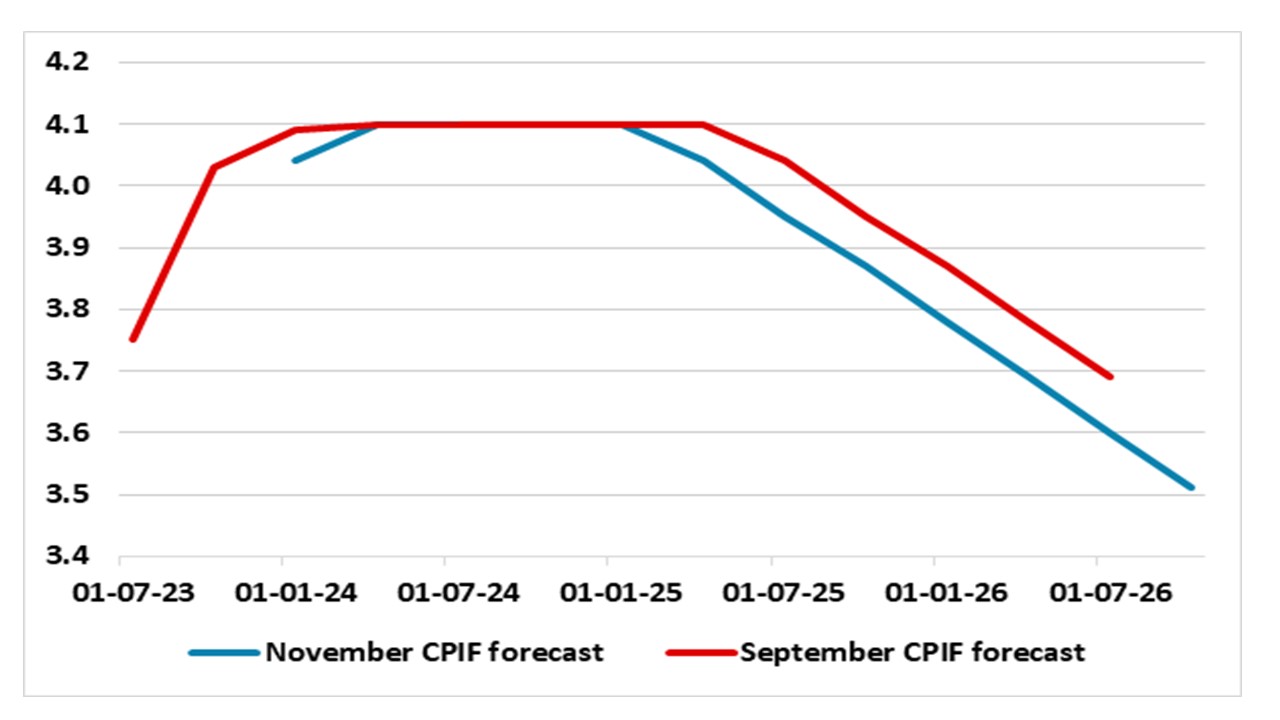Sweden Riksbank Review: Accepts Improving Inflation Picture and Pauses
For some time we have thought that the Riksbank has finished its hiking, and this line of thinking has been borne out by the unchanged policy decision this month, something also contrary to both previous Riksbank guidance and recent consensus thinking. Recent data have continued to be been mixed but both the weaker (underlying) inflation picture and what may be growing Board concerns about financial stability risks inter-related with growing weakness in bank lending and deposits have argued for the policy rate staying at the 4.0% level it rose to in September. Notably, the Riksbank is not ruling out a further hike but still predicts that on current policy inflation will return to target (Figure 1) and stay there in the latter part of its 2-3 year forecast horizon, albeit with some volatility due to energy prices. The Riksbank is not suggesting any near-term policy reversal but has brought forward slightly is anticipated first easing (Figure 2). We think instead that rate cuts may emerge by mid-2024, not least given the even more sizeable output gap the Riksbank is anticipating persisting out to 2026, embracing a cumulative near-2 ppt GDP drop by mid-2024.
Figure 1: Inflation Moving Back to Target Durably
Source: Riksbank
Plunging Price Pressures?
Regardless, the Riksbank inflation outlook retained a much more explicit admission that policy is restrictive, as the Riksbank has taken policy to a terminal rate of around 4% it signalled in June and that this will be adhered to well into 2025. But while this outlook encompasses particularly weak domestic demand, it skates over some of the reason for this as well as the increasing recent repercussions in the form of a broader fall in inflation. Admittedly, the Riksbank has begun to accept an improving inflation picture and outlook, noting that while 'inflation has fallen and inflationary pressures have clearly eased'. Driving this change of view have been recent CPI data, most notably the recently released October CPIF (ie the measure the Riksbank targets).This did see the y/y rate rise afresh and at 4.2% was a notch above Riksbank projections. But this is mainly due to energy-related base effects, something better appreciated by seasonally adjusted m/m readings (computed by CE) for both overall CPIF and the CPIF ex-energy. Indeed, such adjusted data very much show a very much softer profile of late, even excluding energy with the CPIF measure consistent with circa-zero inflation in the last few months. Thus, from our standpoint, the risks may be that inflation returns to target earlier and possibly undershoots target than that thought by the Riksbank from still pointing to return to the 2% target in the coming year.
Financial Stability Considerations
We would also suggest that the bond sales the Riksbank is carrying out (and apparently is considering ramping up) in order to reduce its balance sheet are also having an effect, they helping explain the marked drop in bank credit and deposits now occurring. This issue has not been something that the Riksbank has overtly acknowledged but that may be changing. The recent Riksbank Financial Stability Report very much stressed that higher interest rates are squeezing Swedish property companies, to which domestic banks are very exposed so that while the Swedish financial system is functioning well overall risks remain elevated. Moreover, it is clear that the Riksbank is aware of fragilities in the banking system, not least after last spring's banking problems in the US and Switzerland which showed that banks can lose their deposits much faster than previously thought. It is aware how important it is that banks maintain credit supply and may now be considering negative growth rates for deposits and lending may be at least partly a result of supply problems as well as weak demand.
Figure 2: Slight Shift in Riksbank Policy Outlook

Source: Riksbank
In perspective, the Board's updated scenario alternatives once again envisage risks on inflation and policy in both directions, a contrast to projections prior to April which assessed only upside inflation risks and which now encompasses an implicit recognition of a much more two-way policy outlook. All of which reflects more policy flexibility being demanded and flagged by the Board. We continue to think that the Riksbank is ignoring the broader impact of its policy tightening. After over a year of interest rate hikes, monetary policy is now more explicitly assessed to be contractionary and the Board underscores that it will continue regularly to evaluate how the economy responds to the policy rate hikes already implemented and will adjust monetary policy accordingly. In conclusion, we think hiking is not just paused but finished and we still see rate cuts starting from as soon as Q1 next year.
